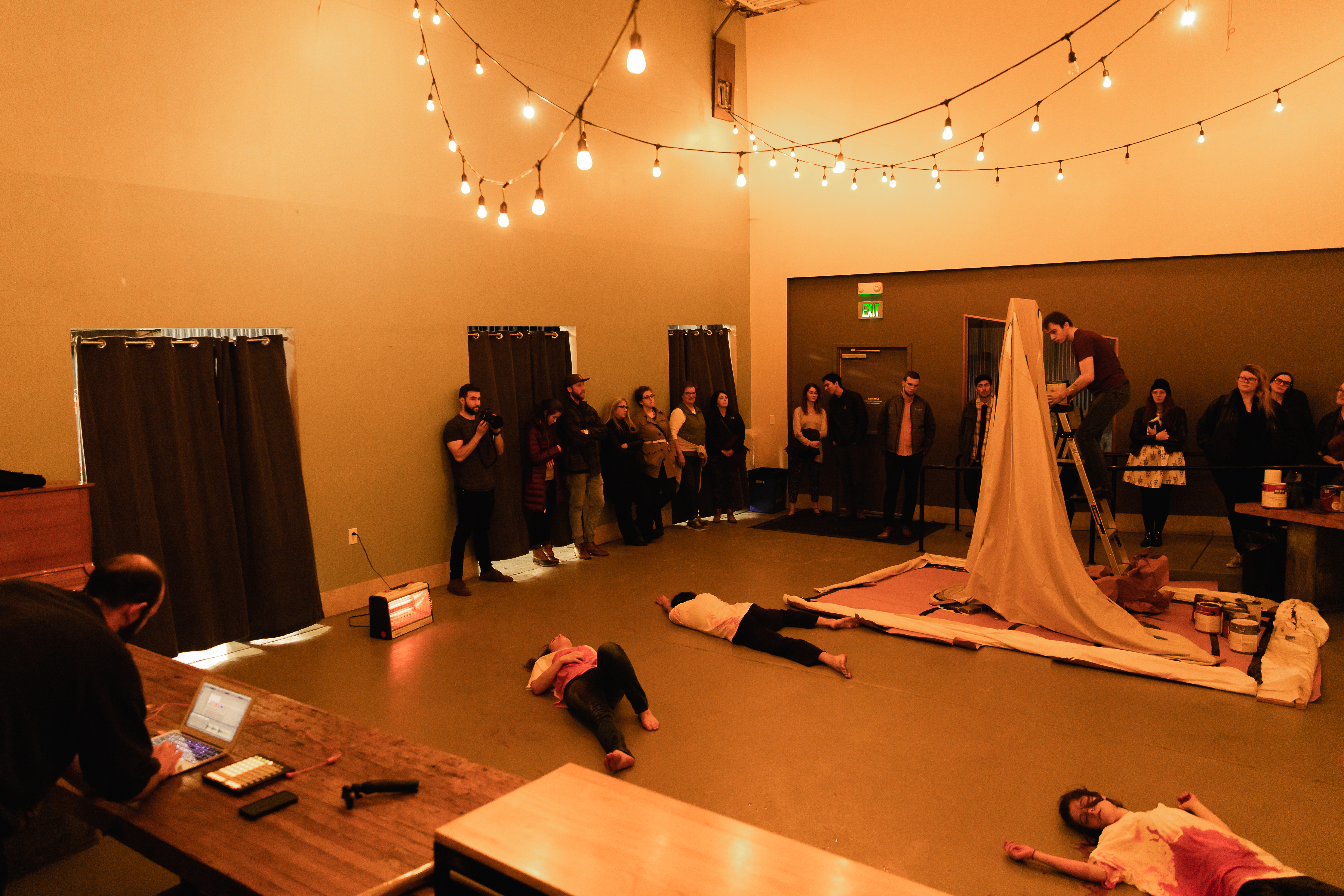The First Cut Never Feels Like a Cut: Mark Macey’s Other/Self
Art
Walking into the performance space for Other/Self is a little unnerving. Sugar Space Arts Warehouse is a jarringly apt fit for the director, Mark Macey, with space to let him and his actors play. It was a one time performance on Feb. 7 that I believe deeply depended on individual experience. So, in an effort to convince you to attend a Macey production, let me tell you how I experienced Other/Self, a confluence of four performances spread across two floors.
As the show begins, the room’s energy starts to take shape. Macey kicks off the performance by performing upbeat electronic music on the bottom floor. Macey’s brother, David Macey, starts opening paint cans, and he soon walks up a ladder to pour over a simple, wooden structure draped in gray cloth. I walk upstairs as the space begins to warm with energy. Here, Jessica Graham is spinning on a platform, wearing a red blindfold and spinning a broom coated in paint that spreads a circle surrounding her. Along this circle are mirrors reflecting upward. As she recites a poem about concepts of the self and group identity, a projection of images envelopes her and creates an odd shape on the corner wall she occupies. Watching her, I can hear Macey’s music downstairs, but it’s only when I peer down over the railing that I see the dancers: Nora Lang, Dat Nguyen and Sofia Sant’Anna-Skites.
When David Macey pours a can of paint slowly, it’s nearly the same color as the draped cloth. As Mark’s music becomes more energetic, the dancers spread red paint on each other, but I have no clue from where it came—it appeared suddenly while I was upstairs, and it seems to spread through touch, sparking a conviviality. Meanwhile, a second coat of paint spills over the cloth; it’s a salmon color, and I feel it so much more than the first, bland coat.
As the dancers move and the audience remains on the sidelines, I feel a surge of energy flow through the room and into me. I find myself wanting to jump in and be a part of the performance, to cross the boundary that we were actually expressly permitted to transgress at the top of the performance: Macey had told us to “treat the dancers like stray cats”—and so I did. I walked into their space, the only person to do so, and I felt myself start to move and sway with them ever so slightly. They felt hot, unafraid to touch each other’s bodies or faces, leaning on each other and collapsing on one another. I felt the giddiness of being seen. The next color poured down: a dark blue that eclipses the pink the almost entirely. It drips freely onto the floor and begins to pool.
At this point I walk back upstairs to check on Graham, and before I can I suddenly I hear a shriek. I look over the railing—a dancer has collapsed on the ground—I have no idea what has happened. The red paint that was once a connective tissue now feels like an untreated wound. An ugly yellow now coats the clothed structure, and because of its shape and the precision of David’s pour, the paint now completely covers all previous coats, mixing only at the bottom.
I move back in between the dancers. No one else is taking the opportunity to enter their space, and so I feel an exciting energy as the audience watches me move between them. I feel conscious, and just of myself but as a performer. Another dancer screams out of seemingly nowhere and falls to the ground. Only one dancer remains, and it’s as if they now dance with me alone. I can’t help but smile.
Soon, as the third person collapses, I suddenly feel as though I’m in the in middle of murder scene. Three corpses surround me—each lifeless. And now the only performer left is me.
As the music ends, David continues to pour paint, and upstairs Graham continues to recite their chant. David announces the end of the performance, but I feel as though I am still performing, like I can never return from the boundary I crossed.
Awareness was a key sensation to this piece. Other/Self embraces the idea of opportunity cost, that paying attention to any one performance may cost you a meaningful moment from another. Stare as the paint cascades down the cloth stand and you may miss the dancers collapsing onto each other in a moment of tenderness—at the same time, watching the dancers, you might miss Graham reach a breaking point in her mantra-like cantation. There’s a sense that something important is always going on in each space, and as an audience member your greatest (and only) resource is your own attention.
So what actually constitutes the total performance? I can only tell you my answer. Whatever you choose to emphasize, whatever scraps your perception gathers from the half-hour builds into a unique, cohesive whole where perspective creates a rhythm of awareness. Implicit in my reading is that comprehension, sensation and consciousness itself erupts out of curiosity—that our impulses to understand almost always end up framing the way meaning is constructed.
And what drives that curiosity? A show like Other/Self is a chance to approach these impulses as tiny pieces. What intrigues you in the moment? Do you watch the dancers, do you listen to the music, do you listen to the poem and hear the music and the shrieking downstairs and try to take it all together? What details do you miss then? And most importantly, do you dare to leave the consciousness of the audience—be subsumed into the performance? What becomes of you if you do?
I recommend looking into what Macey does next, and you can see examples of what I’ve described for yourself at www.markmacey.work.
